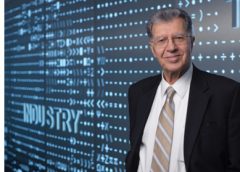Insight Into Cement’s Microscopic Properties May Lead to Stronger, More Sustainable Concrete.
By Mark S. Kuhar
MIT Civil and Environmental Engineering Professor Oral Buyukozturk does research that focuses on mechanics and design of structures and innovative materials. His work in part focuses on behavior and design of concrete structures.
Cement materials, including cement paste, mortar and concrete, are the most widely manufactured materials in the world. The demand for these materials is unlikely to decline any time soon. In the United States, the majority of concrete bridges, buildings and pavement-lined streets, erected in the 1960s and 1970s, were designed in an era with fewer environmental stresses to infrastructure and built to last 50 years at most.
Buyukozturk has discovered the beginnings of a new approach to producing concrete that is inspired by the hierarchical arrangements of simple building blocks in natural materials. The findings could lead to new ways to make concrete stronger and to use more sustainable, local materials as additives, to offset concrete’s greenhouse gas emissions.
In a new study, Buyukozturk analyzed a key property in concrete, at the level of individual atoms, that contributes to its overall strength and durability. His group developed a computer model to simulate the behavior of individual atoms which arrange to form molecular building blocks within a hardening material.
Buyukozturk’s vision for revamped, locally sourced concrete is inspired, in part, by Roman construction.
These simulations revealed that an interface within the molecular structure exhibited a “frictional” resistance under sliding deformation. The team then developed a cohesive-frictional force field, or model, that incorporates these atom-to-atom interactions within larger-scale particles, each containing thousands of atoms. The researchers say that accurately describing the forces within these assemblies is critical to understanding the way strength develops in concrete materials.
The team is now examining ways in which the cohesive and frictional forces of groups of atoms, or colloids in cement, are improved by mixing in certain additives such as volcanic ash, refinery slag and other materials. The team’s computer model may help designers choose local additives based on the molecular interactions of the resulting mixtures. Through careful design at the microscopic level, he said, designers and engineers can ultimately build stronger, more environmentally sustainable structures.
Buyukozturk’s vision for revamped, locally sourced concrete is inspired, in part, by Roman construction. During the empire’s peak, the Romans erected temples, bath buildings and amphitheaters in Pompeii, Ostia, and through Spain and the Middle East, including towns in Turkey, Libya and Morocco. In each far-flung location, archaeologists have found that the Romans constructed their buildings from local materials – a technique that has helped preserve these structures for more than 2,000 years.
Source: MIT

